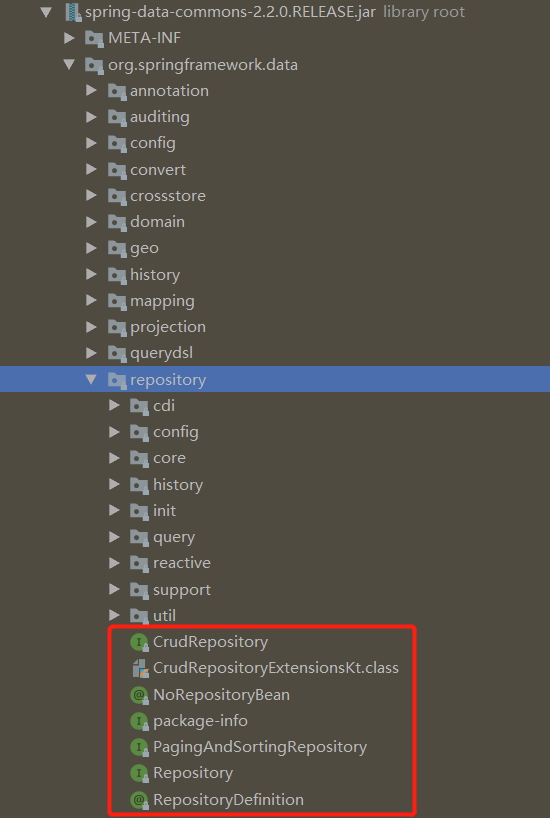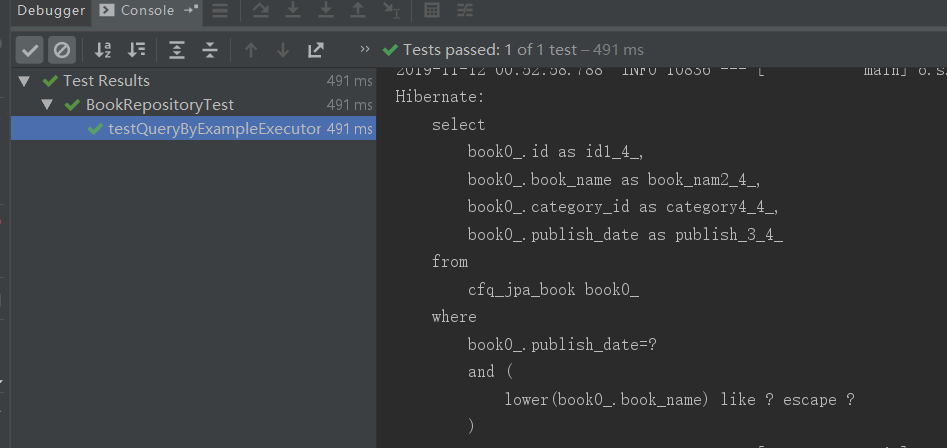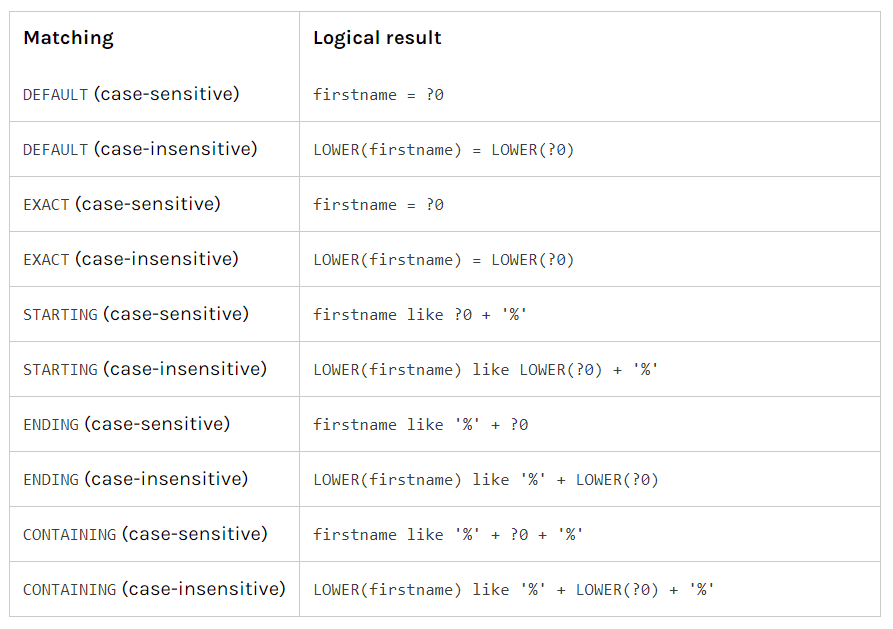1、spring-data-commons项目
spring-data-commons项目是所有spring-data项目的核心,我们来看一下该项目下的repository包中的接口和注解。

2、Repository<T,ID>接口和@RepositoryDefinition注解
当中最重要的就是Repository接口了。它是做数据库操作的最底层的抽象接口、最顶级的父类,打开Repository接口看其源码,发现里面其实什么方法都没有,仅仅起到一个标识作用。捕获要管理的域类型和域类的id类型。用途是保存类型信息,并能够在类路径扫描期间发现继承该接口的接口,帮助我们创建代理类。
@Indexed
public interface Repository<T, ID> {
}
@Indexed 我们发现在Repository接口上有一个@Indexed 注解,是Spring5提供的注解,用于提升应用启动性能。这个注解单独存在不起作用,要想使其生效的话,要添加spring-context-indexer依赖。在编译时会将@CompoentScan扫描指定package中要生成的bean写在METE-INF/spring.components文件中,当项目启动时,就会读取这个文件,不会再扫描指定的package了,从而提升性能。
我们只要继承Repository接口,并根据它的规则来命名接口方法,就可以进行数据库操作。(与继承Repository接口相等价的就是,在接口上添加@RepositoryDefinition注解)
示例:
/** * 书籍持久层 * @author caofanqi * 使用@RepositoryDefinition注解与继承Repository具有相同的效果 *///@RepositoryDefinition(domainClass = Book.class,idClass = Long.class)public interface BookRepository extends Repository<Book,Long>{ /** * 根据书名查找书籍 * @param bookName 书籍名称 * @return 该书籍名称的书列表 */ List<Book> findBooksByBookNameContains(String bookName);}
@Transactional@Rollback(false)
@SpringBootTest
class BookRepositoryTest {
@Resource
private BookRepository bookRepository;
@Test
void findBooksByBookNameContains() {
System.out.println("bookRepository : " + bookRepository.getClass().getName());
List<Book> books = bookRepository.findBooksByBookNameContains("Java");
System.out.println(books);
}
}
这样就会根据我们传入的参数去like查询符合条件的书籍,生成的sql语句如下:

3、CrudRepository<T,ID>接口与注解@NoRepositoryBean
CrudRepository是Repository接口的子接口,提供了一套通用的CRUD方法。接口上的@NoRepositoryBean注解的意思是,不让Spring生成该类的代理类。
@NoRepositoryBean //不让Spring为该类生成代理类,仅仅提供一套通用的CRUD方法。
public interface CrudRepository<T, ID> extends Repository<T, ID> {
/**
* 保存方法*/
<S extends T> S save(S entity);
/**
* 保存*/
<S extends T> Iterable<S> saveAll(Iterable<S> entities);
/**
* 根据id进行查询*/
Optional<T> findById(ID id);
/**
* 判断给定id的数据是否存在*/
boolean existsById(ID id);
/**
* 查询全部,数据量很大的时候,谨慎使用*/
Iterable<T> findAll();
/**
* 根据给定ids查询符合条件的数据
*/
Iterable<T> findAllById(Iterable<ID> ids);
/**
* 统计条数*/
long count();
/**
* 根据id删除*/
void deleteById(ID id);
/**
* 删除给定实体*/
void delete(T entity);
/**
* 删除给定实体*/
void deleteAll(Iterable<? extends T> entities);
/**
* 删除全部
*/
void deleteAll();
}
我们要想使用这些方法,只需自己的Repository继承该接口即可。
4、PagingAndSortingRepository<T,ID>接口
是CrudRepository的子接口,也不会生成代理,只是提供分页和排序的方法。
@NoRepositoryBean
public interface PagingAndSortingRepository<T, ID> extends CrudRepository<T, ID> {
/**
* 根据sort去所有对象排序的集合*/
Iterable<T> findAll(Sort sort);
/**
* 根据pageable进行分页,pageable中可以包含sort*/
Page<T> findAll(Pageable pageable);
}
分页相关对象:
Sort查询的排序选项,至少提供一个属性列表来进行排序,不能是null或空,默认是升序ASC;
可以通过Sort.by 来构建Sort对象:
public static Sort by(String... properties) 根据给定的属性列表进行升序排序;
public static Sort by(Direction direction, String... properties) 指定属性和排序方向,Direction.ASC(升序)、Direction.DESC(降序);
public static Sort by(Order... orders)/public static Sort by(List<Order> orders) 根据给定的一组order进行排序。
可以通过Sort.and()方法将多个sort组合再一起,通过Sort.ascending()/Sort.descending指定排序方向。
还可以通过Sort.sort(Class<T> type) 来构造类型安全的排序对象:
public static <T> TypedSort<T> sort(Class<T> type) 根据指定class类型构造该类型的typeSort排序对象;
通过TypedSort.by 方法来构建排序字段,通过ascending()/descending指定排序方向,使用and()方法进行连接。
Order,实现一个排序对,提供方向和属性,为sort提供输入。也就是说,可以针对每一个属性设置不同的升序或降序。
可以通过一下方式来构建Order对象:
public static Order by(String property) ,指定属性返回order对象,默认使用升序。
public static Order asc(String property),返回指定属性升序的order对象。
public static Order desc(String property),返回指定属性降序的order对象。
Pageable分页信息的抽象接口,实现类是PageRequest;
可以通过一下方式来构建Pageable对象:
public static PageRequest of(int page, int size),创建一个未排序的PageRequest,page从0开始;
public static PageRequest of(int page, int size, Direction direction, String... properties),创建一个根据给定方向和属性排序的分页对象。
public static PageRequest of(int page, int size, Sort sort),创建一个根据sort进行排序的分页对象。
Page,封装分页结果信息,可以通过如下方法获取分页信息。
page.getContent() ,分页查询结果列表;
page.getNumberOfElements(),当前分页结果列表中的元素个数;
page.getTotalElements(),当前条件下总条数;
page.getTotalPages(),总页数;
page.getNumber(),我们自己传的page;
page.getSize(),我们自己传入的size。
代码示例:
@Test void testPagingAndSortingRepository(){// Sort.Order id = Sort.Order.by("id");// Sort.Order bookName = Sort.Order.desc("bookName");// Sort sort = Sort.by(id,bookName); //等价于上面三句代码// Sort sort = Sort.by("id").ascending().and(Sort.by("bookName").descending()); //使用类型安全的排序 Sort.TypedSort<Book> bookTypedSort = Sort.sort(Book.class); Sort sort = bookTypedSort.by(Book::getId).ascending() .and(bookTypedSort.by(Book::getBookName).descending()); Pageable pageable = PageRequest.of(2,2, sort); Page<Book> page = bookRepository.findAll(pageable); System.out.println("分页查询结果列表:" + page.getContent()); System.out.println("当前分页结果列表中的元素个数:" + page.getNumberOfElements()); System.out.println("当前条件下总条数:" + page.getTotalElements()); System.out.println("总页数:" +page.getTotalPages()); System.out.println("我们自己传的page:" +page.getNumber()); System.out.println("我们自己传入的size:" +page.getSize()); }
5、QueryByExampleExecutor<T>接口
该接口位于spring-data-commons项目的repository.query包中,允许通过实例来进行查询,可以通过该接口来进行简单的动态查询。使用的话,自己的repository继承QueryByExampleExecutor并指定域类型,就可以使用它提供的功能了。
public interface QueryByExampleExecutor<T> {
/**
* 根据Example查找一个对象*/
<S extends T> Optional<S> findOne(Example<S> example);
/**
* 根据Example查找一批对象*/
<S extends T> Iterable<S> findAll(Example<S> example);
/**
* 根据Example查找一批对象,并排序*/
<S extends T> Iterable<S> findAll(Example<S> example, Sort sort);
/**
* 根据Example查找一批对象,并分页排序*/
<S extends T> Page<S> findAll(Example<S> example, Pageable pageable);
/**
* 根据Example查找,返回符合条件的对象个数*/
<S extends T> long count(Example<S> example);
/**
* 判断符合给定Example的对象是否存在*/
<S extends T> boolean exists(Example<S> example);
}
ExampleMatcher源码分析:
package org.springframework.data.domain;
import lombok.AccessLevel;
import lombok.EqualsAndHashCode;
import lombok.RequiredArgsConstructor;
import lombok.experimental.FieldDefaults;
import java.util.Collection;
import java.util.LinkedHashMap;
import java.util.Map;
import java.util.Optional;
import java.util.Set;
import java.util.function.Function;
import org.springframework.lang.Nullable;
import org.springframework.util.Assert;
/**
* 用于示例查询(QBE)的属性路径匹配规范
*/
public interface ExampleMatcher {
/**
* 创建一个新的匹配器,默认情况下,probe中所有的非空属性都匹配。即所有的属性条件用and连接。
*/
static ExampleMatcher matching() {
return matchingAll();
}
/**
* 创建一个新的匹配器,probe中所有的非空属性匹配一个即可。即所有的属性条件用or连接。
*/
static ExampleMatcher matchingAny() {
return new TypedExampleMatcher().withMode(MatchMode.ANY);
}
/**
*创建一个新的匹配器,probe中所有的非空属性都匹配。即所有的属性条件用and连接。
*/
static ExampleMatcher matchingAll() {
return new TypedExampleMatcher().withMode(MatchMode.ALL);
}
/**
* 返回一个新的匹配器,忽略给定路径的匹配。属性传入这个方法,生成的条件中就不会包含该属性。一般用于基本数据类型。
*/
ExampleMatcher withIgnorePaths(String... ignoredPaths);
/**
* 返回一个新的匹配器,设置默认的字符串的匹配规则。默认是StringMatcher.DEFAULT(=) 。
*
*/
ExampleMatcher withStringMatcher(StringMatcher defaultStringMatcher);
/**
* 返回一个新的匹配器,忽略大小写匹配(还要看数据库是否支持大小写区分)。
*/
default ExampleMatcher withIgnoreCase() {
return withIgnoreCase(true);
}
/**
* 返回一个新的匹配器,设置是否忽略大小写匹配(还要看数据库是否支持大小写区分)。
*/
ExampleMatcher withIgnoreCase(boolean defaultIgnoreCase);
/**
* 返回一个新的匹配器,设置指定属性的匹配方式(使用lambda方式)。
*/
default ExampleMatcher withMatcher(String propertyPath, MatcherConfigurer<GenericPropertyMatcher> matcherConfigurer) {
Assert.hasText(propertyPath, "PropertyPath must not be empty!");
Assert.notNull(matcherConfigurer, "MatcherConfigurer must not be empty!");
GenericPropertyMatcher genericPropertyMatcher = new GenericPropertyMatcher();
matcherConfigurer.configureMatcher(genericPropertyMatcher);
return withMatcher(propertyPath, genericPropertyMatcher);
}
/**
* 返回一个新的匹配器,设置指定属性的匹配方式(原始方式)。
*/
ExampleMatcher withMatcher(String propertyPath, GenericPropertyMatcher genericPropertyMatcher);
/**
* 属性转换器
*/
ExampleMatcher withTransformer(String propertyPath, PropertyValueTransformer propertyValueTransformer);
/**
* 返回一个新的匹配器,指定属性忽略大小写。
*/
ExampleMatcher withIgnoreCase(String... propertyPaths);
/**
* 返回一个新的匹配器,将probe中的null属性也作为过滤条件。如:bookName is null。
*
*/
default ExampleMatcher withIncludeNullValues() {
return withNullHandler(NullHandler.INCLUDE);
}
/**
* 返回一个新的匹配器,将probe中的null属性忽略,不作为过滤条件。
*/
default ExampleMatcher withIgnoreNullValues() {
return withNullHandler(NullHandler.IGNORE);
}
/**
* 返回一个新的匹配器,设置null值处理器。
*/
ExampleMatcher withNullHandler(NullHandler nullHandler);
/**
* 获得null处理器。
*/
NullHandler getNullHandler();
/**
* 获取默认的字符串匹配器。
*/
StringMatcher getDefaultStringMatcher();
/**
* 如果忽略字符串大小写,返回true。
*/
boolean isIgnoreCaseEnabled();
/**
* 判断是否是忽略属性。
*/
default boolean isIgnoredPath(String path) {
return getIgnoredPaths().contains(path);
}
/**
* 获取忽略属性集合。
*/
Set<String> getIgnoredPaths();
/**
* 属性特定查询方式。
*/
PropertySpecifiers getPropertySpecifiers();
/**
* 是否是全匹配。
*/
default boolean isAllMatching() {
return getMatchMode().equals(MatchMode.ALL);
}
/**
* 是否是任意匹配。
*/
default boolean isAnyMatching() {
return getMatchMode().equals(MatchMode.ANY);
}
/**
* 获取匹配方式。
*/
MatchMode getMatchMode();
/**
* null处理器枚举。
*/
enum NullHandler {
INCLUDE, IGNORE
}
/**
* 回调配置匹配器。
*/
interface MatcherConfigurer<T> {
void configureMatcher(T matcher);
}
/**
* 通用属性匹配。
*/
@EqualsAndHashCode
class GenericPropertyMatcher {
@Nullable StringMatcher stringMatcher = null;
@Nullable Boolean ignoreCase = null;
PropertyValueTransformer valueTransformer = NoOpPropertyValueTransformer.INSTANCE;
public GenericPropertyMatcher() {}
/**
* 通过字符串匹配器,是否忽略大小写构建GenericPropertyMatcher。
*/
public static GenericPropertyMatcher of(StringMatcher stringMatcher, boolean ignoreCase) {
return new GenericPropertyMatcher().stringMatcher(stringMatcher).ignoreCase(ignoreCase);
}
/**
*通过字符串匹配器构建GenericPropertyMatcher。
*/
public static GenericPropertyMatcher of(StringMatcher stringMatcher) {
return new GenericPropertyMatcher().stringMatcher(stringMatcher);
}
/**
* 设置忽略大小写。
*/
public GenericPropertyMatcher ignoreCase() {
this.ignoreCase = true;
return this;
}
/**
* 设置是否忽略大小写。
*/
public GenericPropertyMatcher ignoreCase(boolean ignoreCase) {
this.ignoreCase = ignoreCase;
return this;
}
/**
* 设置区分大小写。
*/
public GenericPropertyMatcher caseSensitive() {
this.ignoreCase = false;
return this;
}
/**
* 包含给定属性值。
*/
public GenericPropertyMatcher contains() {
this.stringMatcher = StringMatcher.CONTAINING;
return this;
}
/**
* 以给定属性值结尾。
*/
public GenericPropertyMatcher endsWith() {
this.stringMatcher = StringMatcher.ENDING;
return this;
}
/**
* 以给定属性值开头。
*/
public GenericPropertyMatcher startsWith() {
this.stringMatcher = StringMatcher.STARTING;
return this;
}
/**
* 精确匹配。
*/
public GenericPropertyMatcher exact() {
this.stringMatcher = StringMatcher.EXACT;
return this;
}
/**
* 默认规则。
*/
public GenericPropertyMatcher storeDefaultMatching() {
this.stringMatcher = StringMatcher.DEFAULT;
return this;
}
/**
* 正则匹配。
*/
public GenericPropertyMatcher regex() {
this.stringMatcher = StringMatcher.REGEX;
return this;
}
/**
* 给定string匹配器。
*/
public GenericPropertyMatcher stringMatcher(StringMatcher stringMatcher) {
Assert.notNull(stringMatcher, "StringMatcher must not be null!");
this.stringMatcher = stringMatcher;
return this;
}
/**
* 设置属性转换器
*/
public GenericPropertyMatcher transform(PropertyValueTransformer propertyValueTransformer) {
Assert.notNull(propertyValueTransformer, "PropertyValueTransformer must not be null!");
this.valueTransformer = propertyValueTransformer;
return this;
}
}
/**
* 用于创建GenericPropertyMatcher。
*/
class GenericPropertyMatchers {
/**
* 忽略大小写的。
*/
public static GenericPropertyMatcher ignoreCase() {
return new GenericPropertyMatcher().ignoreCase();
}
/**
* 不忽略大小写的。
*/
public static GenericPropertyMatcher caseSensitive() {
return new GenericPropertyMatcher().caseSensitive();
}
/**
* 包含。
*/
public static GenericPropertyMatcher contains() {
return new GenericPropertyMatcher().contains();
}
/**
* 以结尾。
*/
public static GenericPropertyMatcher endsWith() {
return new GenericPropertyMatcher().endsWith();
}
/**
* 以开始。
*/
public static GenericPropertyMatcher startsWith() {
return new GenericPropertyMatcher().startsWith();
}
/**
* 精确匹配。
*/
public static GenericPropertyMatcher exact() {
return new GenericPropertyMatcher().exact();
}
/**
* 默认方式。
*/
public static GenericPropertyMatcher storeDefaultMatching() {
return new GenericPropertyMatcher().storeDefaultMatching();
}
/**
* 正则。
*/
public static GenericPropertyMatcher regex() {
return new GenericPropertyMatcher().regex();
}
}
/**
* 字符串匹配模式。
*/
enum StringMatcher {
/**
* 默认,效果同EXACT。
*/
DEFAULT,
/**
* 精确,相等。
*/
EXACT,
/**
* 开头匹配。
*/
STARTING,
/**
* 结尾匹配。
*/
ENDING,
/**
* 包含,模糊匹配。
*/
CONTAINING,
/**
* 正则匹配。
*/
REGEX;
}
/**
* 属性转换器,一般不需要设置。
*/
interface PropertyValueTransformer extends Function<Optional<Object>, Optional<Object>> {}
/**
*/
enum NoOpPropertyValueTransformer implements ExampleMatcher.PropertyValueTransformer {
INSTANCE;
@Override
@SuppressWarnings("null")
public Optional<Object> apply(Optional<Object> source) {
return source;
}
}
/**
* 属性特定查询方式
*/
@FieldDefaults(makeFinal = true, level = AccessLevel.PRIVATE)
@RequiredArgsConstructor(access = AccessLevel.PRIVATE)
@EqualsAndHashCode
class PropertySpecifier {
String path;
@Nullable StringMatcher stringMatcher;
@Nullable Boolean ignoreCase;
PropertyValueTransformer valueTransformer;
PropertySpecifier(String path) {
Assert.hasText(path, "Path must not be null/empty!");
this.path = path;
this.stringMatcher = null;
this.ignoreCase = null;
this.valueTransformer = NoOpPropertyValueTransformer.INSTANCE;
}
public PropertySpecifier withStringMatcher(StringMatcher stringMatcher) {
Assert.notNull(stringMatcher, "StringMatcher must not be null!");
return new PropertySpecifier(this.path, stringMatcher, this.ignoreCase, this.valueTransformer);
}
public PropertySpecifier withIgnoreCase(boolean ignoreCase) {
return new PropertySpecifier(this.path, this.stringMatcher, ignoreCase, this.valueTransformer);
}
public PropertySpecifier withValueTransformer(PropertyValueTransformer valueTransformer) {
Assert.notNull(valueTransformer, "PropertyValueTransformer must not be null!");
return new PropertySpecifier(this.path, this.stringMatcher, this.ignoreCase, valueTransformer);
}
public String getPath() {
return path;
}
@Nullable
public StringMatcher getStringMatcher() {
return stringMatcher;
}
@Nullable
public Boolean getIgnoreCase() {
return ignoreCase;
}
public PropertyValueTransformer getPropertyValueTransformer() {
return valueTransformer == null ? NoOpPropertyValueTransformer.INSTANCE : valueTransformer;
}
public Optional<Object> transformValue(Optional<Object> source) {
return getPropertyValueTransformer().apply(source);
}
}
/**
* 特定属性查询方式集合
*/
@EqualsAndHashCode
class PropertySpecifiers {
private final Map<String, PropertySpecifier> propertySpecifiers = new LinkedHashMap<>();
PropertySpecifiers() {}
PropertySpecifiers(PropertySpecifiers propertySpecifiers) {
this.propertySpecifiers.putAll(propertySpecifiers.propertySpecifiers);
}
public void add(PropertySpecifier specifier) {
Assert.notNull(specifier, "PropertySpecifier must not be null!");
propertySpecifiers.put(specifier.getPath(), specifier);
}
public boolean hasSpecifierForPath(String path) {
return propertySpecifiers.containsKey(path);
}
public PropertySpecifier getForPath(String path) {
return propertySpecifiers.get(path);
}
public boolean hasValues() {
return !propertySpecifiers.isEmpty();
}
public Collection<PropertySpecifier> getSpecifiers() {
return propertySpecifiers.values();
}
}
/**
* 匹配方式。
*/
enum MatchMode {
ALL, ANY;
}
}
示例代码:
@Test
void testQueryByExampleExecutor(){
Book book = Book.builder().bookName("java").publishDate(LocalDate.of(2019,11,11)).id(1L).build();
ExampleMatcher matcher = ExampleMatcher.matching()
.withIgnorePaths("id") //忽略id属性,不管id有没有值,都不作为查询条件。
.withIgnoreNullValues() //忽略属性为null的,不作为查询条件。
.withMatcher("bookName",m -> m.startsWith().ignoreCase()) //设置bookName属性,前包含,忽略大小写。
.withTransformer("publishDate",value -> Optional.of(LocalDate.of(2019,11,12))); //转换属性值
Example<Book> example = Example.of(book,matcher);
List<Book> books = bookRepository.findAll(example);
}
生成的sql语句:

Spring-Data-Jpa官网的字符串匹配举例

QueryByExampleExecutor最佳实践:
首先要判断是否需要我们自己构建匹配器,如果默认匹配器,可以完成,我们就不需要创建。
判断null值是否要作为条件,一般都是忽略的,如果null值作为条件,将不想作为条件的null属性添加到忽略列表。
基本类型是有默认值的,如果不作为条件,要加入到忽略列表。
不同的字符串属性,如果需要不同的匹配方式,进行单独设置。
不是特别复杂的动态查询,使用QBE,还是很方便的。
源码地址:https://github.com/caofanqi/study-spring-data-jpa
来源:https://www.cnblogs.com/caofanqi/p/11831362.html